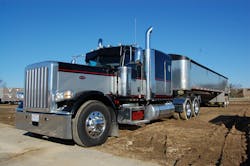Increasing numbers of smaller trucking companies are foundering on the shoals of higher costs and regulatory compliance, according to data compiled for the 26th annual State of Logistics (SOL) report – issued by the Council of Supply Chain Management Professionals (CSCMP) and presented by Penske Logistics.
That trend may also be why trucking capacity will continue getting tighter, explained Rosalyn Wilson, senior business analyst with Parsons Corp. and author of the annual SOL report. “You may think the demise of a smaller carrier operating just 30 trucks doesn’t matter,” she told Fleet Owner ahead of the SOL report’s unveiling at the National Press Club in Washington D.C. “But when you have 400 such companies exiting the industry, that adds up to a lot of capacity.”
Wilson noted that 390 trucking companies went into bankruptcy in the first quarter of 2014 alone; carriers that averaged 27 vehicles each.
She added that Donald Broughton, chief market analyst for Avondale Partners, concluded that “there is a direct link between” new federal truck safety regulations and the rash of small carrier bankruptcies.
“Many of the companies that went out of business were ordered by federal authorities to install electronic logging devices (ELDs) that made it easier to enforce hours of service rules,” he said. “As a result, those companies saw their truck utilization drop as drivers with fewer miles earned less money and quit, forcing carriers to hire and train new drivers, often at higher wages.”
Wilson added that although small trucking companies represent “a small part of the industry” compared to the nation’s largest 13 motor carriers, which operate more than 60,000 vehicles on the road, they are often the only source of competition in the trucking market.
She also pointed out that in terms of new Class 8 truck registrations – which increased 3.8% or by 226,228 to a total of 3.78 million vehicles at the end 2014, according to IHS Automotive – large fleets accounted for 48% of all them.
That represents a 23% rise in new registrations for fleets operating more than 500 trucks, Wilson noted.
About the Author
Sean Kilcarr
Editor in Chief
Sean Kilcarr is a former longtime FleetOwner senior editor who wrote for the publication from 2000 to 2018. He served as editor-in-chief from 2017 to 2018.
